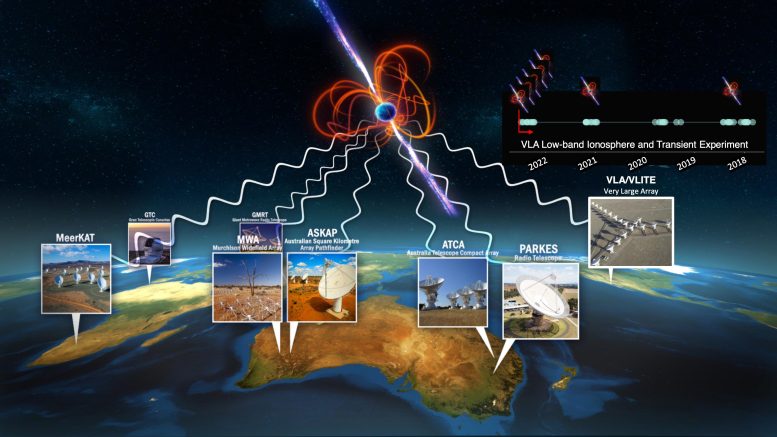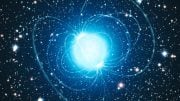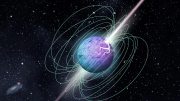
Artist impression of the magnetar that was discovered by the Murchison Widefield Array (MWA) radio telescope and other radio facilities around the world that helped confirm the discovery. Looking back in time using archival data from NRL’s VLITE instrument on the VLA, NRL astronomers were able to time the radio bursts back to 2018. The inset timeline (top right) of VLITE archival observations shows the MWA discovery as a red bar, blue dots are VLITE data sets searched and thumbnails of the magnetar show when VLITE detected the emission. MeerKAT.
Astronomers have confirmed the existence of a unique stellar object, an ultra-long period magnetar, challenging current understanding of neutron star physics. The enigmatic object, discovered in 2022, has been emitting radio waves for decades, sparking interest and opening new research avenues in the study of neutron stars and the universe.
The U.S. Naval Research Laboratory’s Very Large Array (VLA) Low-band Ionosphere and Transient Experiment (VLITE) telescope has been instrumental in assisting astronomers confirm findings of a new stellar phenomenon that challenges current scientific understanding of the physics of neutron stars. The object is believed to be an ultra-long period magnetar, a rare type of star with extremely strong magnetic fields that can produce powerful bursts of energy, a finding that was published on July 19 in the journal Nature.
“Current understanding says this object should not emit radio waves and yet we are detecting them across several decades and we are not sure why. That is an exciting mystery.” — Dr. Tracy Clarke, NRL Research Astronomer and VLITE Project Scientist
NRL’s VLITE was developed in collaboration with the National Radio Astronomy Observatory (NRAO) in 2014. VLITE operates on the VLA as a stand-alone instrument for ionospheric and astrophysical studies. VLITE’s 18 antennas collect over 6000 hours of data per year, which are archived at NRL. Originally it was implemented to constantly monitor the Earth’s ionosphere to study disturbances that can affect it such as geomagnetic storms, seismic events, and gravity waves. By this constant surveillance, it can be used as a tool to detect transient blips, bursts of radio waves from cosmic sources that are elusive without constant observation. Understanding these phenomena may lead astronomers to a better understanding of the Universe.
In September 2022, an international team of astronomers, led by Curtin University and the International Centre for Radio Astronomy Research (ICRAR) in Australia discovered the stellar object (named GPM J1839-10) using the Murchison Widefield Array (MWA). The discovery set off an intense world-wide effort to understand GPM J1839-10. NRL astronomers quickly reprocessed stored VLITE data, identifying previously hidden emission from the stellar object. Armed with the VLITE results, astronomers scoured archives and traced the emission from the source back more than three decades, to 1988.
An animation describing the discovery, the behavior of the object, and what it might look like. Credit: ICRAR
“This enigmatic object has been hiding in the data for decades – we just did not know we had to look for it until its discovery by the MWA,” said Dr. Simona Giacintucci, NRL Research Astronomer. GPM J1839-10 emits a five-minute pulse of radio wavelength emission every 22 minutes, and it’s been doing this for at least 33 years.
“Findings like this are exciting because they highlight the gaps in our understanding of the physics of these extreme stars known as magnetars,” said Dr. Tracy Clarke, NRL Research Astronomer and VLITE Project Scientist. “Current understanding says this object should not emit radio waves and yet we are detecting them across several decades and we are not sure why. That is an exciting mystery.”
Astronomers believe GPM J1839−10 is a form of rare neutron star with extremely powerful magnetic fields. “Astronomy is one of those bizarre professions where we are not able to go to our objects to study them,” Clarke said. “We are interested in how many of these are out there and where they are located. That is directing future research.”
VLITE has exceeded its original mission fulfilling initial hopes of making discoveries just like this. NRL astronomers will continue to search data sets produced with VLITE to lead future discoveries and a better understanding of the Universe with the fascinating objects it contains. NRL’s instrumentation and cutting-edge research supports the mission of the Navy and Department of Defense while continuing to contribute to science worldwide.
For more on this discover, see Astronomers Find Mysterious Stellar Object Emitting Radio Waves Every 22 Minutes.
Reference: “A long-period radio transient active for three decades” by N. Hurley-Walker, N. Rea, S. J. McSweeney, B. W. Meyers, E. Lenc, I. Heywood, S. D. Hyman, Y. P. Men, T. E. Clarke, F. Coti Zelati, D. C. Price, C. Horváth, T. J. Galvin, G. E. Anderson, A. Bahramian, E. D. Barr, N. D. R. Bhat, M. Caleb, M. Dall’Ora, D. de Martino, S. Giacintucci, J. S. Morgan, K. M. Rajwade, B. Stappers and A. Williams, 19 July 2023, Nature.
DOI: 10.1038/s41586-023-06202-5
Image Credit: South African Radio Astronomy Observatory (SARAO), Gran Telescopio Canarias; Daniel López/IAC, Murchison Widefield Array; Marianne Annereau, Giant Metrewave Radio Telescope; NCRA, Australian SKA Pathfinder; CSIRO/DragonflyMedia, Australia Telescope Compact Array; CSIRO, Parkes Radio Telescope, Murriyang; CSIRO, Very Large Array; AUI/NRAO









An idea I’ve suggested before, involving flawed diamondlike lattices of joined quark orbitals in cold or gravitationally-compressed objects, seems to fit this nicely. Maybe quakes and flaws in such lattices can create isolated massive areas of coherent gravitational flows facilitating and conducting low frequency EM radiation.
And how with these fantastic discoveries benefit mankind on the backs of the bankrupt governments and starving taxpayers forced to fund grandiose research?
When quantum mechanics was discovered, no one could imagine that it would be foundation of the next technological revolution. And in any event, if you want to save money, start thinking of bigger expenses like trillion dollar bank bailouts.
Shortsightedness is a path to stagnancy, not to riches.